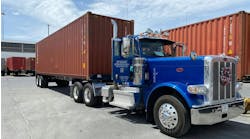“Technology moves on,” Don Winn, div. engineering manager – chassis & powertrain, told FleetOwner. “We knew going in there would be greater thermal loads due to EGR and there were several possible approaches to take.
“We elected to develop a new, high-performance cooling module that effectively brings the product up to the next generation of design to meet the needs of EGR engines,” he continued. “To do so, we worked closely with our cooling system suppliers.”
Peterbilt has completed its application engineering for the’02-certified Cummins ISX and ISM engines using its new cooling module, according to program manager Mark Cooper.
Cooper said the OEM worked with Modine and other cooling-system suppliers to develop the module, which was designed as a system that incorporates the radiator, coolant, charge-air cooler and the various auxiliary coolers.
Creating the module required a new look at the side-by-side arrangement of the radiator and charge-air cooler first introduced on the Pete 387 to ensure both units received the maximum amount of inlet air.
To accommodate EGR, the two units were kept next to each other, but the setup was essentially turned on its side for better packaging especially under the 387’s sloped hood.
Another feature of the revised cooling system is a “fairly major change,” said Cooper. “Switching from a bolted copper/brass to a braised aluminum radiator. An all-welded radiator is more reliable.”
So far, according to Winn, the new cooling module has been implemented for all Peterbilt’s “high-volume” models.
“It’s important to bear in mind that it is the volume of heat – not the temperature – that is at issue," said Winn. "We feel we can handle the greater volume produced by EGR through the greater efficiency of the cooling module. It’s a smarter design.”


